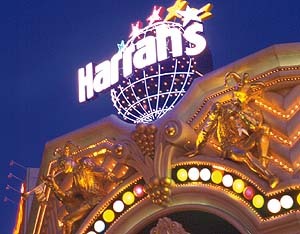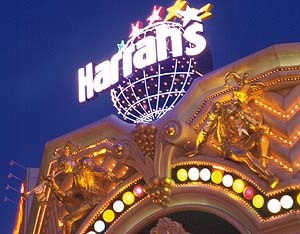Invariably, new and alternative technology is perceived as a threat to established interests. Sometimes that threat is real, and traditional methods rapidly become obsolete. In the case of neon and fiber optics, however, it seems evident that what’s good for the goose is equally good for the gander.
Although neon is clearly ascendant in the sign industry today, its unparalleled success has created new opportunities for fiber optics. Each technology involves a colored light source that can be molded to a variety of custom shapes and forms; this core concept has strong appeal to retail designers. Given the basic differences between neon and fiber optics, the vast market for malleable lighting obviously presents many instances where fiber optics represents a sensible and desirable alternative. In view of neon’s unabated boom, fiber optics shouldn’t be perceived as a threat, but as an enhancement to a vigorous sector of the industry.
Applications
Both end-lit and side-lit fiber optic (FO) cables are utilized in signage and accent lighting applications. Smaller enclosed channel letters can be illuminated with end-lit cables installed through the letter backings. Large channel letters and plastic-faced signs are internally illuminated with side-lit cables arranged in rows like neon tubes. Side-lit cables can also be used in place of neon border tubing for cove lighting, or to accent building outlines. Bridges, towers and other structures can also be high-lighted with side-lit FO cables.
End-lit cables are also used in exposed applications to form letters, or to create star-field displays. Inwave Corp. (Eugene, OR) has developed a fiber optic matrix where individual end-lit FO cables are employed as pixels in a full-color display. The non-electrical nature of illuminated FO cable makes it suitable for many applications where neon may not be possible or desirable.
The following are some examples:
• Signs and accent lighting for inaccessible or severe-weather locations (bridges, towers, piers, etc.).
Advertisement
• Signs and lighting located where accidental human contact is likely (to eliminate the hazards of electrical shocks or broken glass).
• Lighting and signage used under water or in connection with fountains and waterfalls (pools, public aquariums, waterparks).
• Accent lighting used to trim around signs, poles and awnings: In recent years, many sign companies have increased the use of neon to highlight the perimeters of plastic-faced signs. In these applications, neon-system faults can ignite the sign faces, or the tubing can be broken during maintenance.
• Inlaid applications for architectural signs, graphics and lighting: FO cable can be embedded in a variety of substrate surfaces, because the clearances and maintenance access required for neon do not apply. Examples include FO cables installed in pavements, railings, masonry walls, or stone, marble and granite surfaces.
• Automobile, truck, marine and aircraft markings: Because it’s not affected by shocks, vibration or weather, FO cable is a sensible choice for all types of vehicles.
Recognition as a mainstream technology in the sign industry begins when nationwide corporations climb aboard your bandwagon. |2091| (Orlando, FL) took a major stride in that direction as a result of the firm’s relationship with Red Lobster Restaurants (Orlando, FL). Super Vision
Advertisement
SuperVision’s 5/8-in.-diameter side-lit FO cable was installed in the center of a white, metal U-channel extending around the entire perimeter of the Waterford, MI, location’s exterior. According to Fritz Meyne, Jr., SuperVision’s vice president of sales, "The advantage of fiber optics in a very cold environment like this is that colors other than red can be used without any dimming effect." Also, the fact that 100 ft. of FO cable can be run between illuminators gives the user a continuous line of lighting. Although some local codes don’t permit it, the Waterford installation incorporates synchronized color changing. $image2
Inside, Red Lobster’s custom-made, hand-painted signs (manufactured by Nautical Furnishings, Ft. Lauderdale, FL) employ 3/8-in.-diameter side-lit FO cable for the illuminated lettering. The need to ship complete interior signs from the manufacturer to various restaurant locations made unbreakable FO cable an excellent choice for Red Lobster. Each sign consumes a maximum of 200 watts of electricity, and the FO illuminators are UL-rated as portable lamps, allowing them to be plugged into ordinary wall or ceiling receptacles. The new interior FO signs are being installed in Red Lobster’s remodeled locations, as well as many new restaurants.
In another sign-related application, |2150| (Costa Mesa, CA) provided FO cable to illuminate portions of the ornate facade at Harrahs Las Vegas. The facade was designed by Henry Conversano and Assoc. (Oakland, CA), and the fiber-optic lighting scheme was designed by the Henry Elwyn Gee Group (Novato, CA). The indirect cove lighting at the top and bottom of the facade consists of Lumenyte’s Linear Emitting Fiber (LEF), which is lighted with 60-watt Quiet Lightning™ xenon metal halide illuminators. The gold court jesters on the facade are accented with 19mm Lumenyte end-lit cables. Lumenyte
Fiber futures
Although neon retains bragging rights in terms of sheer lighting punch, fiber optics continues to improve in quality, while new applications are found that capitalize on its unique characteristics. The ultimate impact of fiber optics in the sign industry will obviously be significant. Equally clear is the fact that this future success won’t necessarily come at the expense of a thriving neon trade. In contrast to some of the early hype, the current situation benefits the industry by expanding the options for sign specifiers and designers.
Source List
The following companies produce fiber optic cable for sign and related applications.
Atohaas Americas Inc.
100 Independence Mall W.
Philadelphia, PA 19106
(215) 592-3000
Fax: (215) 592-2445
Advertisement
Fiber Optic Systems Inc.
2 Railroad Ave.
Whitehouse Station, NJ 08889
(800) 809-3674
Fax: (908) 534-2272
Fiberstars, Inc.
2883 Bayview Dr.
Fremont, CA 94538
(800) 327-7877
Fax: (510) 490-3247
Inwave Corp.
750 Commercial St.
Eugene, OR 97402
(541) 343-1334
Fax: (541) 342-3806
Lumenyte Intl. Corp.
350 Lear Ave.
Costa Mesa, CA 92626
(714) 556-6655
Fax: (714) 556-9329
Internet: http://www.lumenyte.com
SuperVision Intl.
8210 Presidents Drive
Orlando, FL 32809
(407) 857-9900
Fax: (407) 857-0050
E-mail (sales): mailto:meyne@svision.com


 Photo Gallery1 week ago
Photo Gallery1 week ago
 Ask Signs of the Times1 week ago
Ask Signs of the Times1 week ago
 Paula Fargo6 days ago
Paula Fargo6 days ago
 Real Deal3 days ago
Real Deal3 days ago
 Benchmarks2 weeks ago
Benchmarks2 weeks ago
 Photo Gallery6 days ago
Photo Gallery6 days ago
 Women in Signs1 week ago
Women in Signs1 week ago
 Women in Signs1 week ago
Women in Signs1 week ago

















